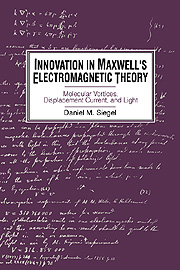Book contents
- Frontmatter
- Contents
- Preface
- Introduction
- 1 The background to Maxwell's electromagnetic theory
- 2 Mechanical image and reality in Maxwell's electromagnetic theory
- 3 The elaboration of the molecular-vortex model
- 4 The introduction of the displacement current
- 5 The origin of the electromagnetic theory of light
- 6 Beyond molecular vortices
- Conclusion
- Appendix 1 Draft of “On Physical Lines of Force,” a fragment
- Appendix 2 Drafts of “A Dynamical Theory of the Electromagnetic Field”
- Appendix 3 Vortex rotations in a curl-free region
- Notes
- Index
2 - Mechanical image and reality in Maxwell's electromagnetic theory
Published online by Cambridge University Press: 24 October 2009
- Frontmatter
- Contents
- Preface
- Introduction
- 1 The background to Maxwell's electromagnetic theory
- 2 Mechanical image and reality in Maxwell's electromagnetic theory
- 3 The elaboration of the molecular-vortex model
- 4 The introduction of the displacement current
- 5 The origin of the electromagnetic theory of light
- 6 Beyond molecular vortices
- Conclusion
- Appendix 1 Draft of “On Physical Lines of Force,” a fragment
- Appendix 2 Drafts of “A Dynamical Theory of the Electromagnetic Field”
- Appendix 3 Vortex rotations in a curl-free region
- Notes
- Index
Summary
As he pursued the task of constructing a unified account of electromagnetic phenomena from a field-theoretic point of view – from his initial explorations under Thomson's tutelage in 1854 through his work on a second edition of the Treatise on Electricity and Magnetism in the months before his death in 1879 – Maxwell was unwavering in his basic commitment to a broad mechanical framework, within the confines of which this task was to be carried out. Within this broad mechanical framework, however, there were various methodological options at Maxwell's disposal – traceable to his experiences at both Edinburgh and Cambridge, and also to his interaction with William Thomson – and Maxwell was to make full use of this variety of options, in response to the shifting needs of his evolving research program. In brief, Maxwell started out using an analogical approach to mechanical representation, rooted in Scottish skepticism and reflecting a desire to proceed with minimal physical commitment at the outset; in this context, he presented the mechanical images in his first major paper on electromagnetic theory, “On Faraday's Lines of Force” (1855–6), as purely illustrative, with no claim whatever to realistic status. Subsequently, responding to William Thomson's judgment that the time had come to go beyond mere analogy in electromagnetic theory and to begin the task of constructing a realistic mechanical theory, Maxwell developed his molecular-vortex representation of the electromagnetic field in the paper entitled “On Physical Lines of Force” (1861–2).
- Type
- Chapter
- Information
- Innovation in Maxwell's Electromagnetic TheoryMolecular Vortices, Displacement Current, and Light, pp. 29 - 55Publisher: Cambridge University PressPrint publication year: 1992



